This Robot has had several guises over the years. From large, round, eyes with lamps in them and large ears with microphones, to a female form with curly hair breasts on the chest plate, and then one with insulators on its head. It also has many names, including The ROBOTER, ALPHA, Astra*, Mary Ann, Eric, Albi/Algi.
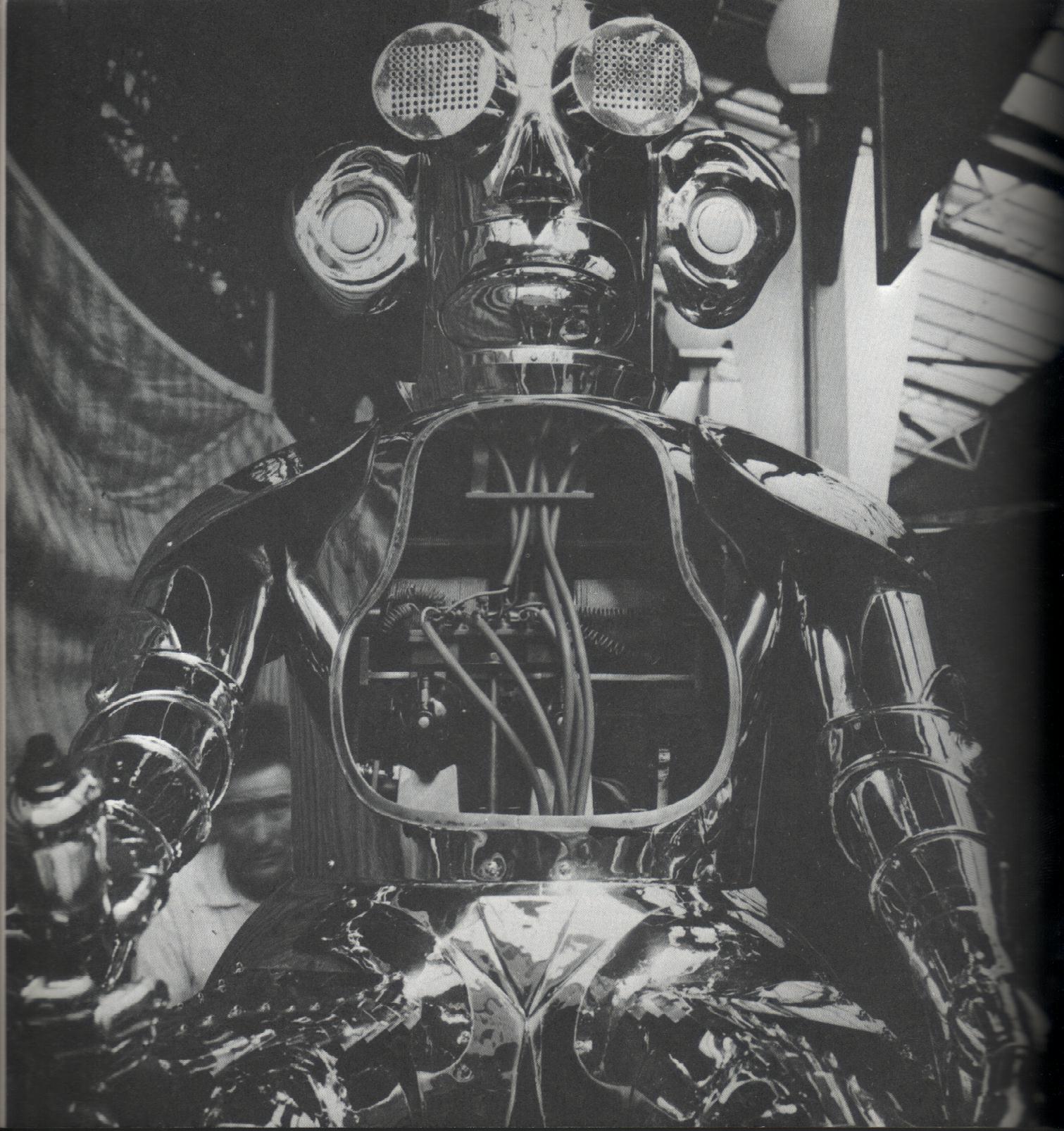

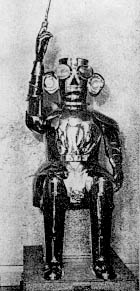
Robot Alpha
Time magazine
Monday, Nov. 05, 1934
Last week Alpha, the robot, made its first public appearance in the U. S. One of the most ingenious automatons ever contrived by man, a grim and gleaming monster 6 ft. 4 in. tall, the robot was brought to Manhattan by its owner-inventor-impresario, Professor Harry May of London, and installed on the fifth floor of R. H. Macy & Co.'s department store. Encased from head to foot in chromium-plated steel armor, Alpha sat on a specially constructed dais with its cumbrous feet securely bolted to the floor, stared impassively over the knot of newshawks and store officials waiting for the first demonstration. The creature had a great sullen slit of a mouth, vast protuberant eyes, shaggy curls of rolled metal. In one mailed fist Alpha clutched a revolver.
Professor May, a dapper, blond, beak-nosed man in his middle thirties, signaled his assistant who drew a curtain behind the stage, revealing the massive control cabinets to which the robot was wired.
Said the crisp British voice of Professor May: "Wake up!"
The eyes of the automaton glowed red.
"Stand up!"
The robot clicked and whirred. Pivoting at knees and waist, it slowly stood up.
"Raise your right arm." Alpha gave a tremendous Nazi salute.
When commanded, the robot lowered its arm, raised the other, lowered it, turned its head from side to side, opened and closed its prognathous jaw, sat down. Then Impresario May asked Alpha a question:
"How old are you?"
From the robot's interior a cavernous Cockney voice responded:
"Fourteen years."
May: What do you weigh?
Alpha: One ton.
A dozen other questions and answers followed, some elaborately facetious. When May inquired what the automaton liked to eat, it responded with a minute-long discourse on the virtues of toast made with Macy's automatic electric toaster. Finally when May requested the creature to raise its arm and fire the pistol, the arm went up, the metal forefinger pulled the trigger, the firing-pin fell with a click. Professor May explained that store officials would not permit him to use blank cartridges.
Alpha's master asked his auditors to give any of his questions and commands, using exactly the same words. Sometimes the robot responded promptly, sometimes not until Professor May repeated the words.
For such pictures as King Kong Hollywood has devised automatons capable of more complex movements than Alpha, but never one that responded to the human voice. Anxious to avoid any suspicion of ventriloquism or of a hidden assistant pushing control buttons, Professor May removed the robot's breast plate, disclosing a mechanism like the interior of an ordinary radio. Publicly he explained that Alpha's repertory of answers consisted of 20 or 30 recordings on wax cylinders, as in oldtime phonographs, which were run off in the control cabinets and reproduced from the loud speaker in the robot's chest. Alpha cannot really understand language, but he can respond to a variety of set questions the answers to which have been prepared in advance.
Privately Professor May explained more. Heart of the robot system is an ordinary cathode-ray oscillograph, an electronic device which, when voice modulations are converted into electrical impulses as in a telephone, makes a jagged up-and-down record of them. Since different voices are differently pitched the device is rigged to ignore absolute pitch but to respond to relative pitch variations which occur in sequence in certain word combinations as pronounced by most speakers. Different combinations of variations close different combinations of relay circuits, and each combination of circuits is hooked up to the appropriate wax cylinder which supplies the answer, or to the proper motor which moves the robot as directed. Thus Alpha may answer "Seven" when asked "How many days in the week?" but remains dumb if the question is phrased "A week has how many days?"
Alpha was not quite correct in giving its age as 14. Professor May, a clever free-lance experimenter in electronics who is now working on voice-operated safes for banks, conceived Alpha 14 years ago but did not endow the robot with its present versatility until last year. He says it is now foolproof although it has not always been so. Once it fired its pistol without warning, blasting the skin off the professor's arm from wrist to elbow. Another time it lowered its arm unexpectedly, struck an assistant on the shoulder, bruised him so badly that he was hospitalized.
Robot in these pics was referred to as "ASTRA". In a separate artcle from the San Antonio Light 11 Sept 1932 p4 reported that back in England, the inventor himself wanted to be called "ASTRA", not the robot.
*I've seen another image where ASTRA is the name of the inventor, not he Robot.

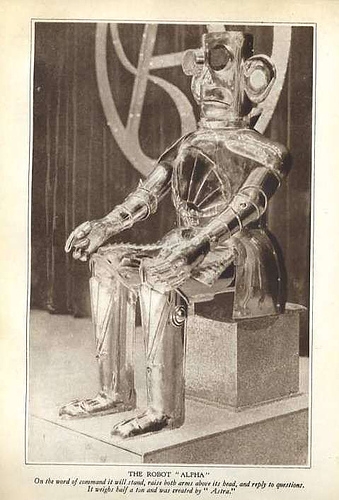
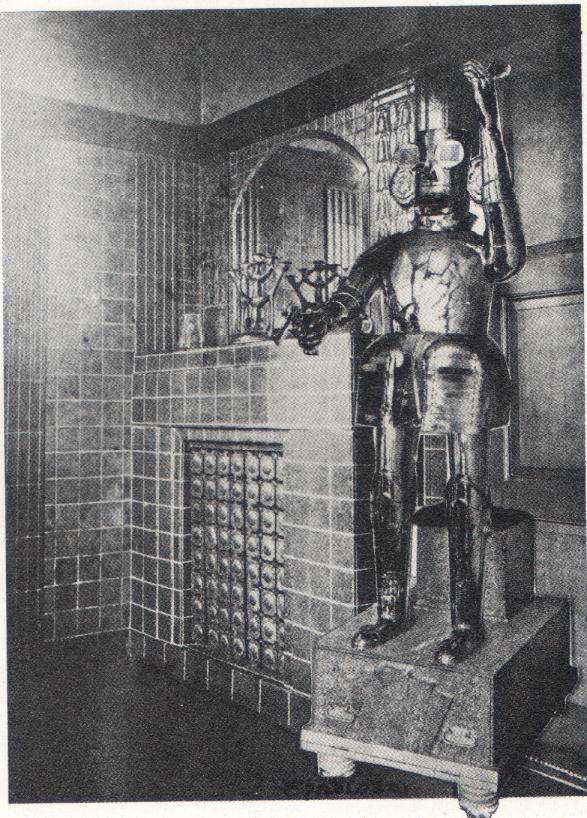
(above) English artist / sculptor Eduardo Paolozzi used Alpha in one of his 1960 collage 'Dr Dekker's Entrance Hall'.
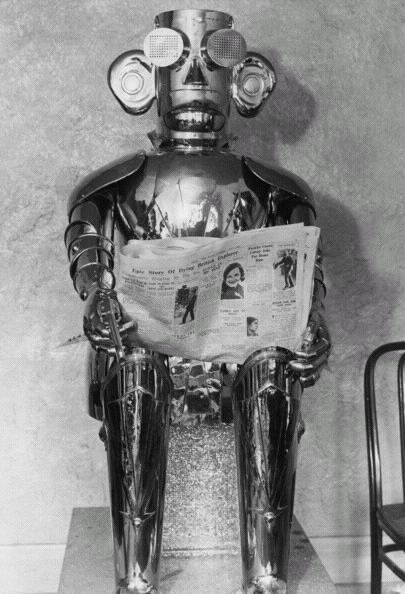

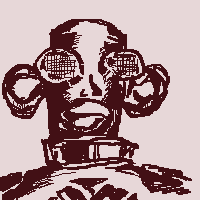


Havas Zsigmond: Az acélember. Ifjúsági regény. A Tolnai Világlapja karácsonyi számának dijtalan melléklete. SebÅ‘k Imre rajzaival. Budapest, 1936.
The steel man. Hungarian youth novel, 1936. Author: Zsigmond Havas. Cover and illustration: Imre Sebők.
Image source – see here.

ALPHA at OLYMPIA – Alpha appeared on the Mullard Valve Company stand at the London Radio Exhibition at Olympia, 1932.
.jpg)
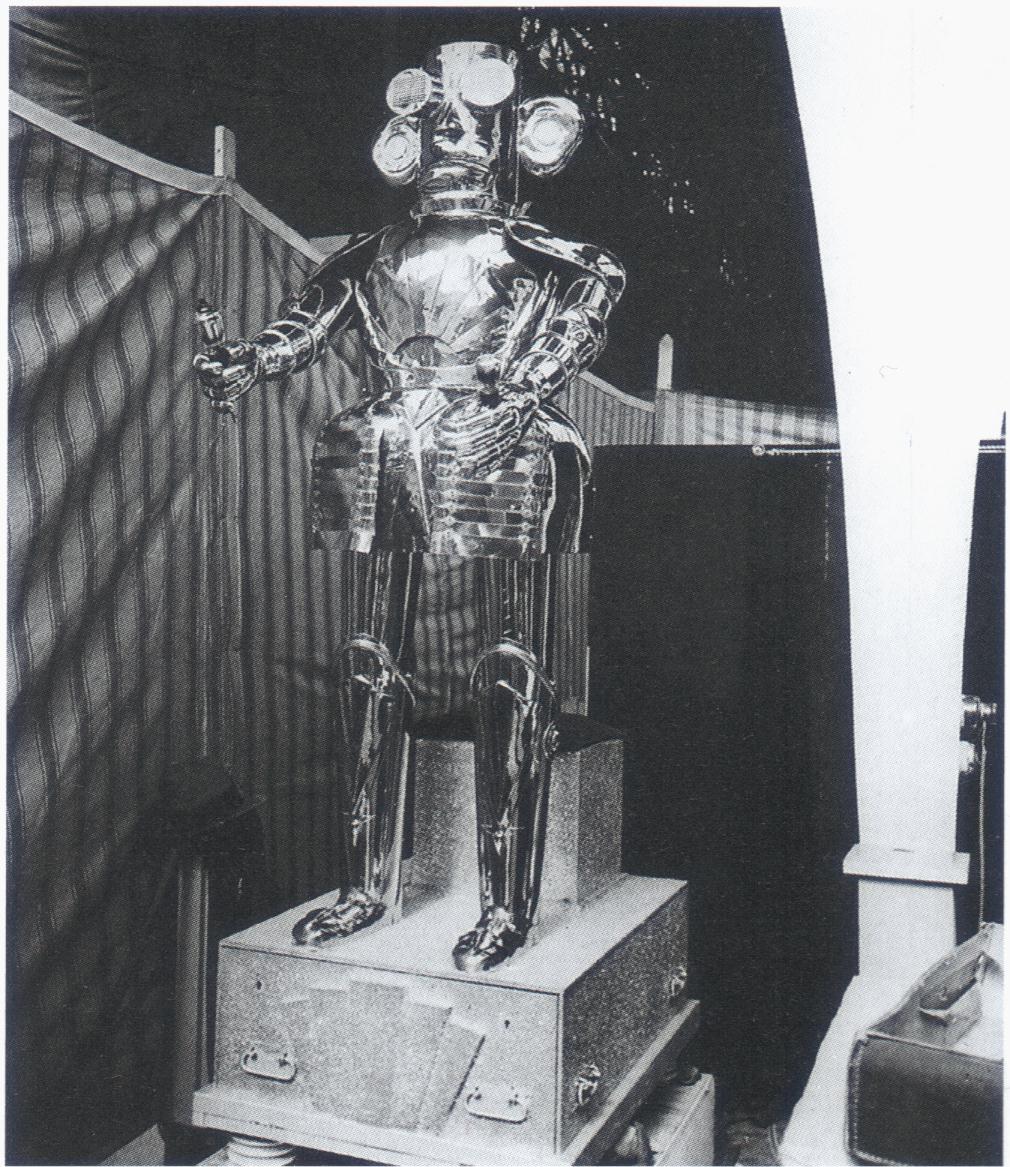

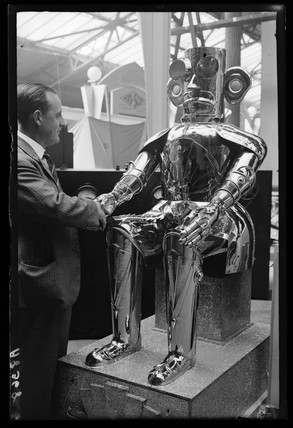

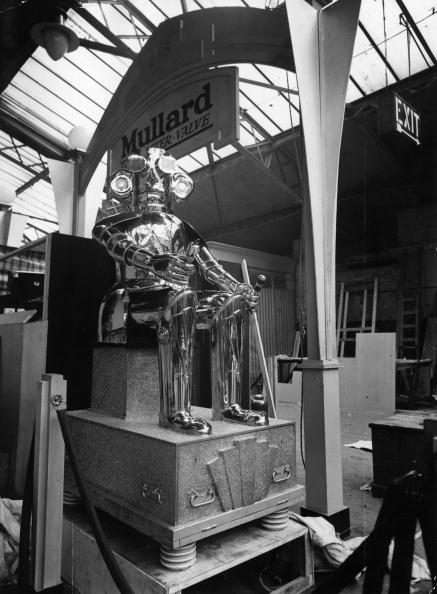
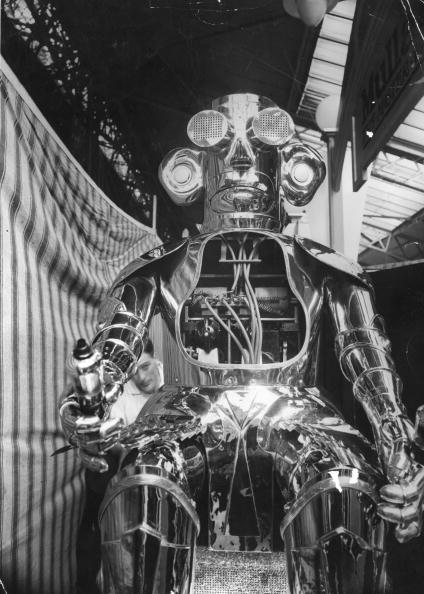
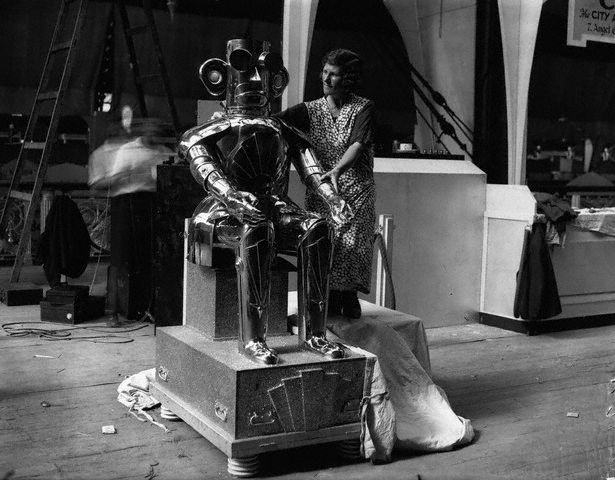
FEMALE FORM (ASTRA* / ALPHA / Mary Ann)
I think there was only one Roboter/Alpha/Astra*/Eric by which either the head was replaced, and also the chest plate changed (breasts or no breasts), or no chest plate at all. I have not been able to piece together any evidence that there were multiple copies made.
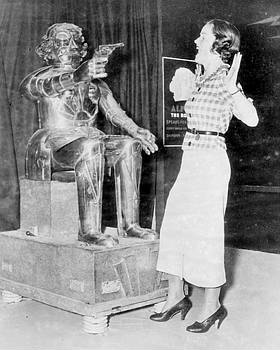
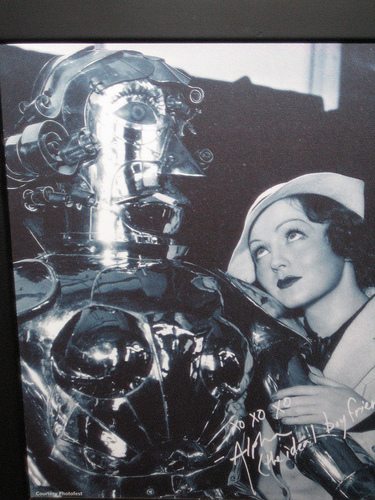

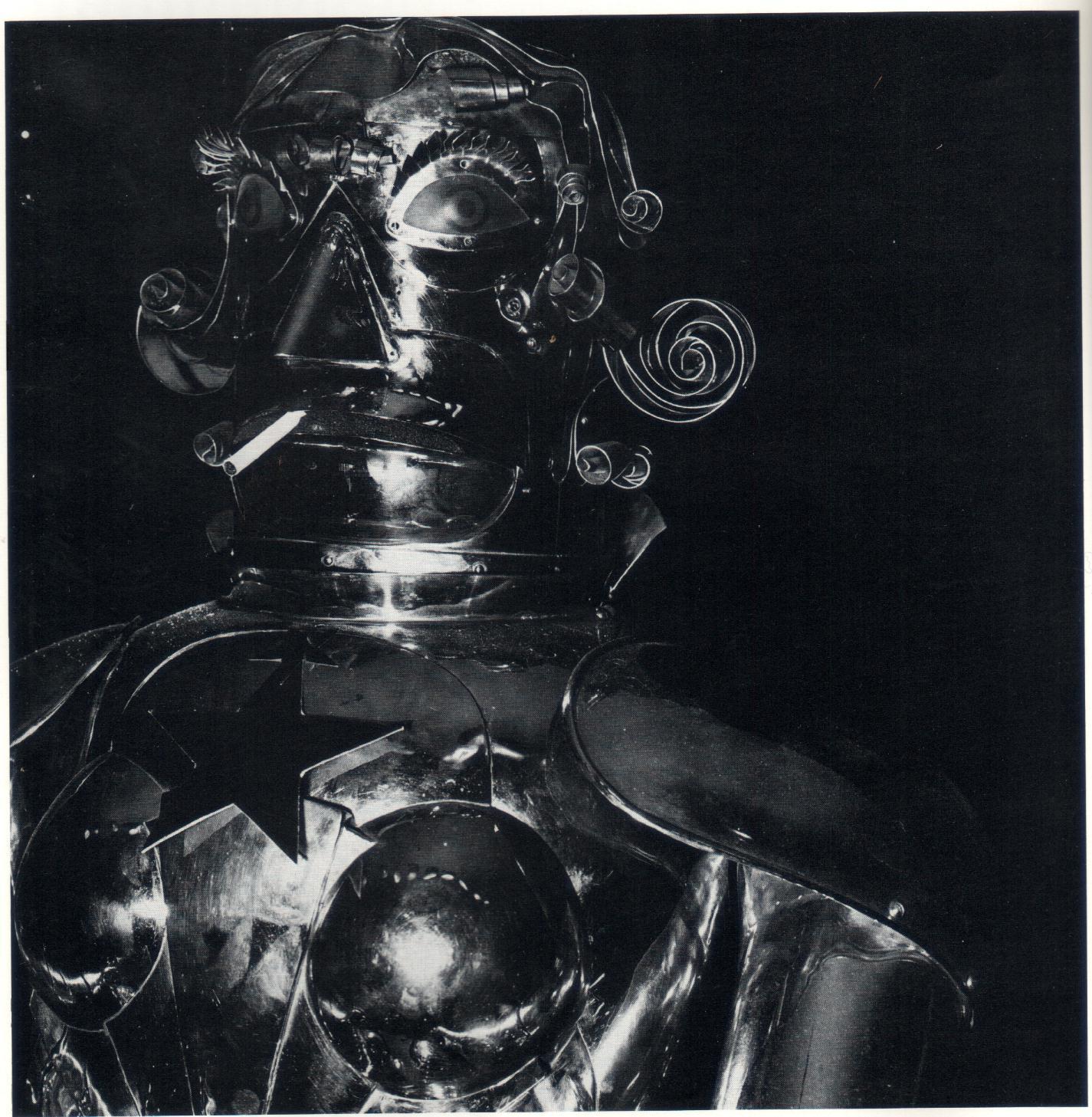

31 Jan 1935, New York, New York, USA — Let George Jessel, Al Jolson and other famous masters of ceremony beware. For now we have "Alpha" the mechanical man (robot), acting as master of ceremonies in "contrast," the revue at the Radio City Music Hall. Here Alpha is announcing the next number, as some dancing girls wait, "on their toes." — Image by © Bettmann/CORBIS

Gender Problems
Although in female form (head with curly hair, long eye-lashes, breasts), there are still images, movies clips, and press articles that refer to the female form as "The Perfect Boyfriend". The movie clips suggest the same, as one will deduce by the conversation and the masculine voice used.
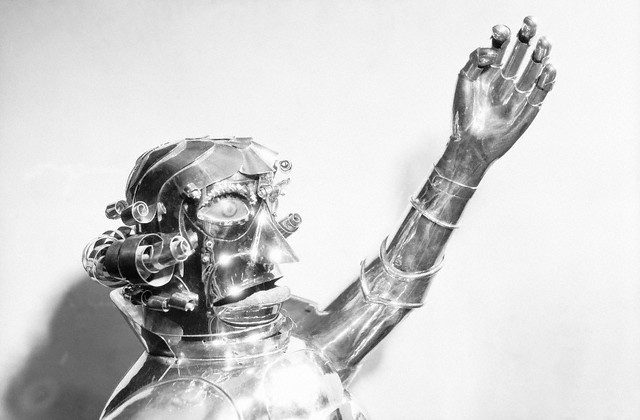
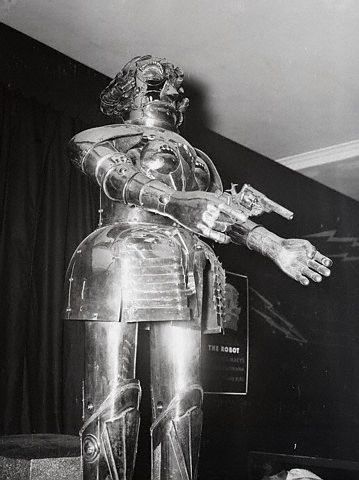
1935 version of Alpha. San Diego Exposition.
Alpha, the Robot, was one of the exhibits in the Palace of Science (now Museum of Man). The 1935 Official Guide Book stated that Professor Harry May, Alpha's inventor, could make the 6 ft., 2 in., 2,000 pound mechanical man roll its eyes, open and close its mouth, shake its head, sit down, stand up, move its arms, fires a revolver, and answers questions with amazing precision.
Video – Pathe News' THE FACE OF THINGS – TO COME! (ALPHA THE ROBOT) 6/12/1934
Alpha the Robot answers questions from a man and flirts with a girl. Here's the blurb that goes with it – Titles read: 'The face of things – TO COME!' – Location of events unknown – United States of America?Various shots show a huge talking robot man with curly hair called 'Alpha'. A man beside him asks him to raise his arm and fire a pistol, which he does. In reply to the man's questions Alpha says he is 6 feet tall and weighs 1 ton.
The man asks if Alpha likes little boys or little girls and the robot says "No!" He does like the ladies so a young brunette girl appears and asks Alpha if he is married. He says not yet and tells her he likes blondes. The girl looks discouraged. When told by the man to take another look at the brunette Alpha decides that "She'll do!".
This is a weird one!
Note: according to paperwork this film originated in the USA and the girl has an American accent, but the man and the robot sound English. Paperwork lists Mr Yearsley and Mr Redknap as having sections of narration – perhaps it was dubbed, or maybe it was just an American story about an eccentric Britisher! (comments made by British Pathe).
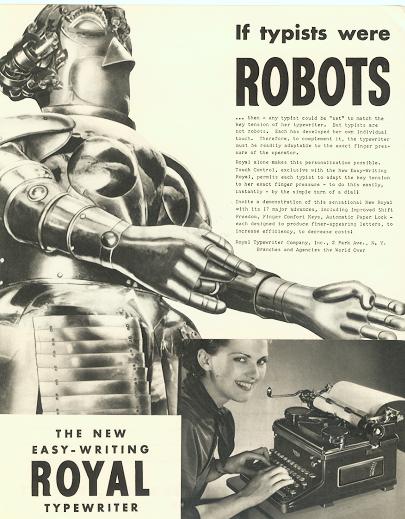
Dangerous Robot!

Portsmouth Times 23 Sep 1932 p25
IT was going to be a very scientific evening. A large group of dignified British society folk had gathered at Brighton, England, to see Harry May demonstrate the marvelous versatility of Alpha, his enormous, wireless-controlled mechanical man.
Mr. May had so perfected his two-ton robot, it was said, that the mechanical man responded immediately to spoken orders to smoke, read newspapers, walk, telltime, and even answer questions. It was whispered, too, that at the climax of the performance Mr. May would get Alpha to shoot a gun at a target. Well, the show went on and the macabre monster the inventor had created did his stuff with amazing precision and with almost human intelligence. The audience was thrilled but just the least bit frightened. The, thing was, even when scientifically explained, a little too uncanny for comfort. They were convinced that it was by no trickery or hocus-pocus that May operated the steel-encased robot. At the beginning of the performance the inventor had exposed the anatomy of Alpha by removing the steel partition that covered its chest.
The spectators saw's highly intricate arrangement of mechanical and electrical apparatus. They had been further enlightened by May's explanation that various tones of his voice, carried on air waves to the monster, set the hidden machinery in operation, resulting in Alpha doing almost everything a human being could do. There was an impressive lull. The lights in the hall were extinguished. A ghastly', blue spot-light, the only illumination in the hall, shone down on the gigantic figure of Alpha and the smaller one of his creator. "And now, ladles and gentlemen," said May, "I will demonstrate to you what is perhaps the most astounding accomplishment in this mechanical man's repertoire. At a spoken word of command he will pick up a revolver and fire a bullet directly at the target on the rear wall.
Through the mind of every person present crept the memory of Mrs. Shelley's tragic and terrible fiction story of "Frankenstein," the man who created a mechanical monster that destroyed him. Despite the suave ease and complete mastery May had so far exhibited in controlling the monster, many could not hut feel that in teaching the brute of steel to shoot off a gun the inventor was tempting the fates, going a little too far. "It's a blank cartridge in the gun, I hope," exclaimed one nervous onlooker in the crowd. "Oh, no," explained May, "In order to demonstrate the confidence I have in Alpha I have for this ono occasion put a real bullet in the revolver. He will shoot it when .I direct him to. Alpha's mechanism is so delicately sensitive to my voice that he will not only fire the gun but he will aim it perfectly and will score a bull's eye on the target you see before you." A murmur went through the crowd. The nervous onlooker and two or three others started for the door. "Please wait a minute, ladies and gentlemen. I assure you there is no danger," pleaded the man en the stage. Reluctantly the frightened men and women mice more took their seats. May walked over and placed a loaded revolver in the robot's "hand."
"Before performing this feat," said the lecturer, "I will try to explain how Alpha accomplishes these marvels, which you have seen and which no other robot has ever been able to master. "You. have heard him talk, answer my questions, read newspapers. This monster, which resembles a man in armor, can do almost anything I ask him. Photo-electric cells are concealed in the gratings that cover his eyes, and his ears are disguised microphones. When you see him obey my commands as you have tonight, he is acting without any other human aid. And now, ladies and gentlemen—" He turned towards "Alpha" but as he did so a startled cry left his lips. Women in the audience screamed and men shouted warnings. Without awaiting May's orders, Alpha had risen from his seat and was pointing the revolver right at his maker! The nightmarish story of Mrs. Shelley was coming true in real life — right before the fashionable English society group's eyes!
"Stop, Alpha. stop!" ordered the frightened May. "Drop that gun and sit down."
But almost as he spoke the monster took a step forward — and fired. May instinctively put up his hand, and this probably saved his life, for the fired projectile shattered the inventor's right hand held close to his throat. In the excitement that followed the monster stood stock-still pointing the revolver. Mr. May's voice could be heard exhorting Alpha, "Back to your chair, Alpha, and drop that gun." To the astonishment of all, the mechanicaI man obeyed instantly, the revolver clattered to the floor and he backed up step by stop and sat down in the chair. "Now, stay there." said May. Five minutes later the hall was empty of everybody but Mr. May and Alpha. When the inventor was attended by a doctor for his punctured }land, he was philosophical about the mishap. "I always had a feeling." he said, "that Alpha would turn on me some day, but this is the first time he ever disobeyed my commands. I can't understand why he fired before I gave the proper signal." Far from discouraged, Mr. May will continue his interesting work. But it was not announced whether target practice for Alpha would be included henceforth in his regular routine.
Winnipeg Free Press
WINNIPEG, THURSDAY,'SEPTEMBER 6, 1934
Robot At Toronto Show Turns on Custodian and Smashed Him on Shoulder
(Canadian Pressss Despatch.)
Toronto, -Sept; 6.—Michael Harley, of London,- England, custodian of "Alpha," the robot woman being displayed at the Canadian National exhibition, Wednesday crept from hospital with a sore shoulder and a bad case of the jitters. He went back.to look after "Alpha" with some trepidation after she belted him Tuesday with" a mailed fist and knocked him to the floor. He was standing with his back to her. He had uttered no word of command, but suddenly the mechanical woman swung on him. '"Alpha," 'after turning on her master, stood motionless and expressionless till someone else started ordering her around.
The latest guise…(San Diego 1936).

ALPHA San Diego 1936
San Diego Sun, February 29, 1936, EXPOSITION EDITION
Robot Alpha Nearly Human: Professor Harry May presents Alpha the Robot in a metallic theater in the heart of the Fun Zone; he also presents the Death Ray machine in another part of the Exposition.
Alpha the Robot, a 2000-lb., chrome-plated, steel giant, received visitors in the Palace of Science. He stood up, sat down, answered questions, smoked cigarettes, blinked his eyes, and fired a pistol on command.77 When Alpha was asked if he loved his wife, he replied ungallantly: "I've a heart of steel. I don't love nobody and nobody loves me."78
Alpha was not the technical marvel he appeared to be since an unseen operator controlled many of his movements.79
San Diego Union (hereafter SDU),
78. SDU, 7-19-35, 5:6-7.
79. Erwine, p. 69.53. San Erwine, "The 1935 Expo: Sally Rand and the midget men to the Rescue," in San Diego Magazine, Vol. 17,June 1965, pp. 66-71.

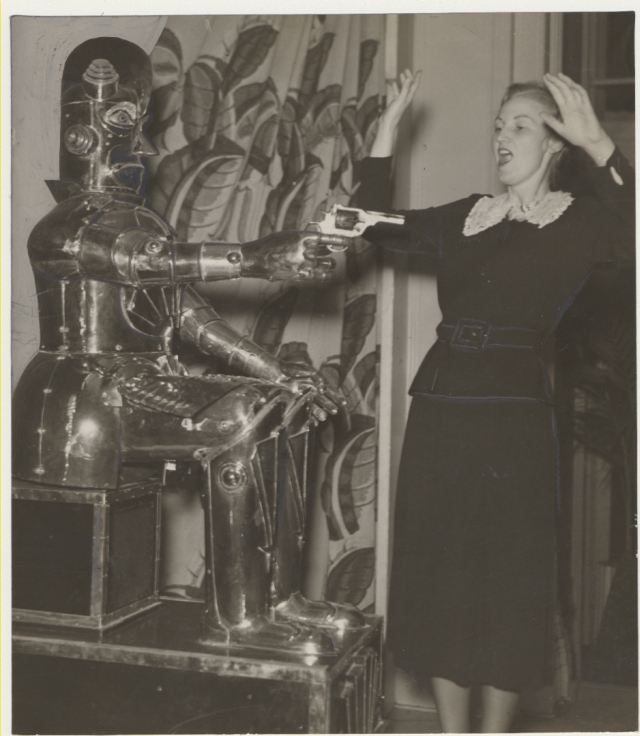
Above: Touched-up press photo shows incorrect bulbous head profile.
Identity problems:
Probably due to the success of Capt. Richards "Eric the Robot", one of the film clips (British Movietone here – you need to register first, then search for "ERIC THE ROBOT" ) refers to Alpha as Eric. As mentioned above, this robot has had other names, including The ROBOTER, ALPHA, Astra, Mary Ann and Albi/Algi.
Anatomy:
The below picture was claimed to be the anatomy of "Alpha". Access to Alpha's innards appeared to be via its chest, and this image has what appears to be the entire back section removed. The image is very unclear. If someone can verify it, or link itwith anoth robot, please let me know. My email address is on the "About" page.
Interesting mention of the Star and Garter Home in Richmond, U.K. and that May may have been involved in prosthetics.

Alpha survives today, watching passer-byers from the front window in Fanny Ann's Saloon in Sacramento. (left of window, facing right).

"Hey Reuben, yes there is one of those alpha's in the front window at Fanny Ann's.Years ago I got the arm to move up and down and turn his head. The wiring is so bad that it started smoking so I unplugged him. I had an electrician look at him, but the cost was way too high,but here he sits watching all the people go by. If your in town stop by and check him out."
Mac@ Fanny Ann's Saloon
Thanks to Bob Pierlock for the advice and Mac McCulloch, the owner who confirmed it.
The Practical Mechanics (February, 1934) article below reveals a little about how Alpha works. It is generic and gleans information from Capt Richards "Eric", and Wensley's "Televox".
Like most robots of the times, Alpha probably had several modes of operation. From a sequence of actions based on a voice signal (I suspect sound control, but not tone control i.e. any loud sound within close vicinity would trigger it. Another possiblilty is that once triggered into a sequence of actions, it is the operator who is in sync with the command sequence, so rather than giving the commands, they are pre-emptying the next command sequence. When it comes down to question and answer, again it is a choreographed event, with a pre-recorded recording (wax cylinder, movie/talkies film), or in most cases an out-of-sight operator using a wireless link. Depending upon the event, any or all of these controls may have been deployed.




Thanks Bob, I’ll try and check that out.
I think this is the same “Robot” on display at Fanny Ann’s bar in Old Sacramento, California!
I’m so happy to have read all this about my cousin, whom I knew. He stayed with my family when he was presenting the robot at the World’s Fair at Flushing Meadow.
Joanne Dryansky
good article as usual!